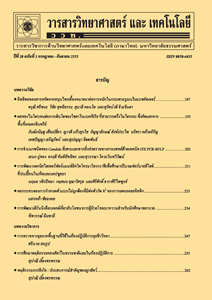การหาสภาวะที่เหมาะสมต่อการผลิตกรดอะซิติกในระหว่างกระบวนการหมักน้ำส้มสายชูจากเนื้อผลกาแฟ
Main Article Content
Abstract
Abstract
The objective of this research was to study the optimum conditions of acetic acid production for fermented vinegar from coffee pulp. Variables used to study the optimal conditions of acetic acid production for fermented vinegar from coffee pulp include concentration of alcohol (6-10 %, by volume), concentration of glucose (6-14 %, w/v) and concentration of bacteria (5-15 % by volume). Furthermore, optimal combination of these variables were determined using respond surface methodology (RSM) by Box-Behnken design (BBD). The results showed that all three factors affected the acetic acid. Statistical analysis indicated that the experimental data should be fitted to the quadratic polynomial equation because of it high coefficient of determination with R-square 0.8926. When using mathematical equations to create three-dimensional graphs, response surface areas and outline graphs to find the optimal conditions in this experiment. It was found that the optimum conditions (8 % alcohol, 12 % glucose, and 10 % bacteria), that resulted in the highest acetic acid content were 2.99±0.18 percent. In those conditions, the total phenolic compounds were 229.40±0.882 mg GAE/g DW and had antioxidant activity, measured as a percentage of DPPH free radical inhibition were 38.21±0.745.
Keywords: acetic acid; fermented vinegar; coffee pulp; Box-Behnken design (BBD)
Article Details
References
[2] ชุติมณฑน์ พลอยประดับ, พุทธพร เจียมศุภกิตต์ และนิรมล ปัญญ์บุศยกุล, 2553, ฤทธิ์การต้านออกซิเดชั่นของส่วนต่าง ๆ ของผลกาแฟอาราบิก้าและกากกาแฟ, ว.วิทยาศาสตร์เกษตร 41(3/1): 577-580.
[3] Liu, J., Gan, J., Yu, Y., Zhu, S., Yin, L. and Cheng, Y., 2016, Effect of laboratory-scale decoction on the antioxidative activity of Zhenjiang Aromatic Vinegar: The contribution of melanoidins, J. Funct. Foods 21: 75-86.
[4] ปรีชา มุณีศรี, 2538, น้ำส้มสายชูหมักจากไวน์เปรี้ยว (vinegar), ว.ศูนย์บางพระ, 1: 42-46.
[5] Álvarez-Cáliz, C., Santos-Dueñas, Inés M., García-Martínez, T., Cañete-Rodríguez, Ana M., Millán-Pérez, M. Carmen, Mauricio, Juan C. and García-García, Isidoro., 2014, Effect of biological ageing of wine on its nitrogen composition for producing high quality vinegar, J. Food Bioprod. Proc. 92: 291-297.
[6] Johnston, Carol S., Quagliano, Samantha and White Serena, 2013, Vinegar ingestion at mealtime reduced fasting blood glucose concentrations in healthy adults at risk for type 2 diabetes, J. Funct. Foods 5: 2007-2011.
[7] เจนจิรา ชุมภูคำ, วีระพงษ์ ทรัพย์นำ และทัศไนย จารุวัฒนพันธ์, 2557, ผลของอัตราส่วนประกอบต่อคุณภาพของไวน์เปลือกกาแฟและความพึงพอใจของผู้บริโภค, ว.แก่นเกษตร, 42(3)(ฉบับพิเศษ): 415-420.
[8] เกศินี ตระกูลทิวากร, 2525, การศึกษาความแก่และคุณภาพของผลมะม่วงพันธุ์น้ำดอกไม้ที่มีความแก่ต่าง ๆ ที่เก็บรักษาในตู้เย็น, สถาบันค้นคว้าและพัฒนาผลิตภัณฑ์อาหาร มหาวิทยา ลัยเกษตรศาสตร์, กรุงเทพฯ.
[9] Kaisoon, O., Siriamornpun, S., Weerapree yakul, N. and Meeso, N., 2011, Phenolic compounds and antioxidant activities of edible flowers from Thailand, J. funct. foods 3: 88-99.
[10] Shimada, K., Fujikawa, K., Yahara, K. and Nakamura, T.,1992, Antioxidative properties of xanthan on the autoxidation of soybean oil in cyclodextrin emulsion, J. Agric. food chem. 40: 945-948.
[11] มาตรฐานผลิตภัณฑ์ชุมชน, ไวน์ผลไม้, แหล่งที่มา : http://tcps.tisi.go.th/public/StandardList.aspx, 20 เมษายน 2561.
[12] Narkprasom, N., Narkprasom, K. and Upara, U., 2015, Optimization of total phenolic from Cleistocalyx nervosum by microwaveassisted extraction, Amer. J. Eng. Appl. Sci. 8: 302-309.
[13] วราวุฒิ ครูส่ง และพงสวัสดิ์ มานิต, 2532, เทคโนโลยีการหมักในอุตสาหกรรม, โอ เอส พริ้นติ้งเฮาส์, กรุงเทพฯ.
[14] Sakurai, K., Yamazaki, S., Ishii, M., Igarashi, Y. and Arai, H., 2013, Role of the glyoxylate pathway in acetic acid production by Acetobacter aceti, J. Biosci. Bioeng. 115: 32-36.
[15] ประมวล ทรายทอง, บทบาทของแบคทีเรียกรดอะซิติกในอุตสาหกรรมอาหาร, แหล่งที่มา : http://158.108.94.117/Public/PUB0629.pdf, 10 กรกฎาคม 2561.
[16] ชื่นจิต จันทจรูญพงษ์, นัชดา ราชนิยม และณัฎวัลย์ พลพันธุ์, 2561, การศึกษากระบวนการผลิตน้ำส้มสายชูหมักจากโคจิข้าวเหนียว, ว.วิทยาศาสตร์และเทคโนโลยี มหาวิทยาลัยราชมงคลธัญบุรี 8(1): 130-140.
[17] จุฑามาศ มณีวงค์, 2551, การผลิตน้ำส้มสายชูจากสาโท, รายงานการวิจัย, มหาวิทยาลัยแม่โจ้, เชียงใหม่, 42 น.
[18] ชญาณ์พิสุทธิ์ แก้วสุวรรณ์, นรารัตน์ เทียนชัยทัศน์, สุดาวดี มโนรมณ์ และหนึ่งฤทัย ห้าวหาญ, 2555, การผลิตเครื่องดื่มน้ำส้มสายชูหมักเพื่อสุขภาพจากน้ำเชื่อมเปลือกสับปะรด, รายงานการวิจัย, มหาวิทยาลัยราชมงคลธัญบุรี, ปทุมธานี, 65 น.
[19] ประวีณา ลาภา, เพ็ญขวัญ ชมปรีดา, และวิชัย หฤทัยธนาสันต์, 2544, การพัฒนนาผลิตภัณฑ์น้ำส้มสายชูหมักข้าวกล้องเหนียวดำ, รายงานการวิจัย, มหาวิทยาลัยเกษตรศาสตร์, กรุงเทพฯ, 8 น.
[20] Zhao, L., Liu, F., Wu, L., Xue, X. and Hou, F., 2017, Fate of triadimefon and its metabolite triadimenol in jujube samples during jujube wine and vinegar processing, Food Control 73: 468-473.
[21] กาญจนา นาคประสม, จตุรภัทร วาฤทธิ์, อุมาพร อุประ, หยาดฝน ทนงการกิจ และนักรบ นาคประสม, 2560, สภาวะที่เหมาะสมในการสกัดสารประกอบฟีนอลิกรวมจากดอกบัวหลวงโดยใช้เทคนิคสกัดด้วยไมโครเวฟ, ว.วิทยาศาสตร์ มข. 45(2): 328-342.
[22] ประกาศกระทรวงสาธารณะสุข, น้ำส้มสายชูหมัก, แหล่งที่มา : http://food.fda.moph.go.th/law /data/announ_moph/P204.pdf, 9 กรกฎาคม 2561.


